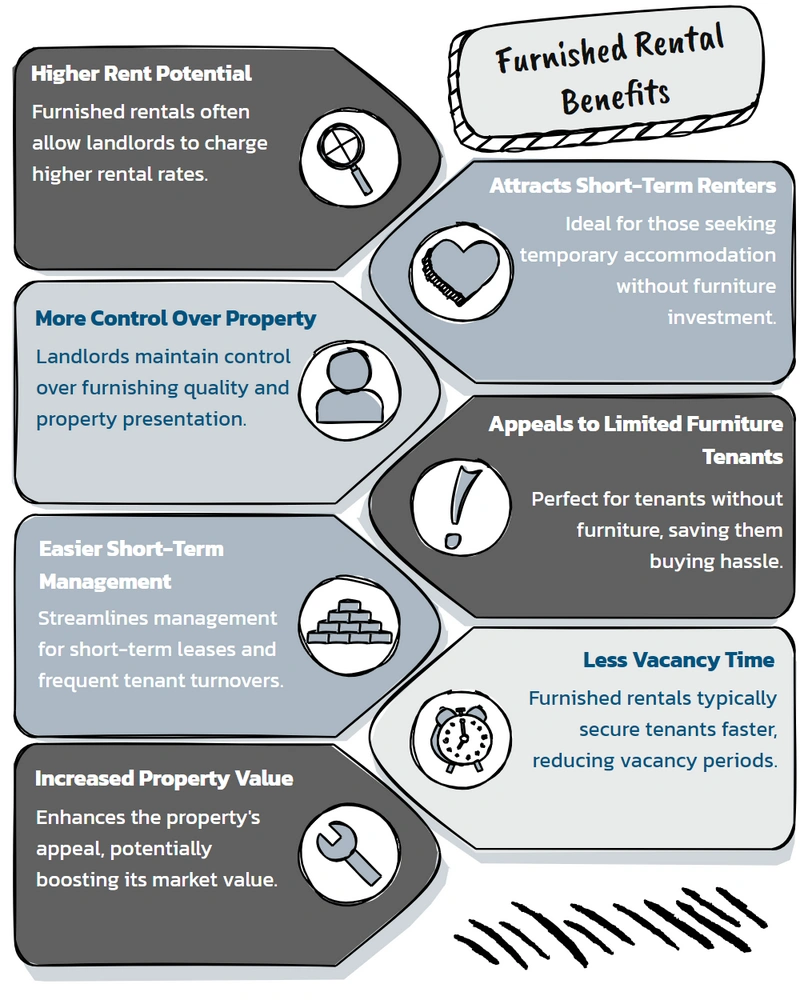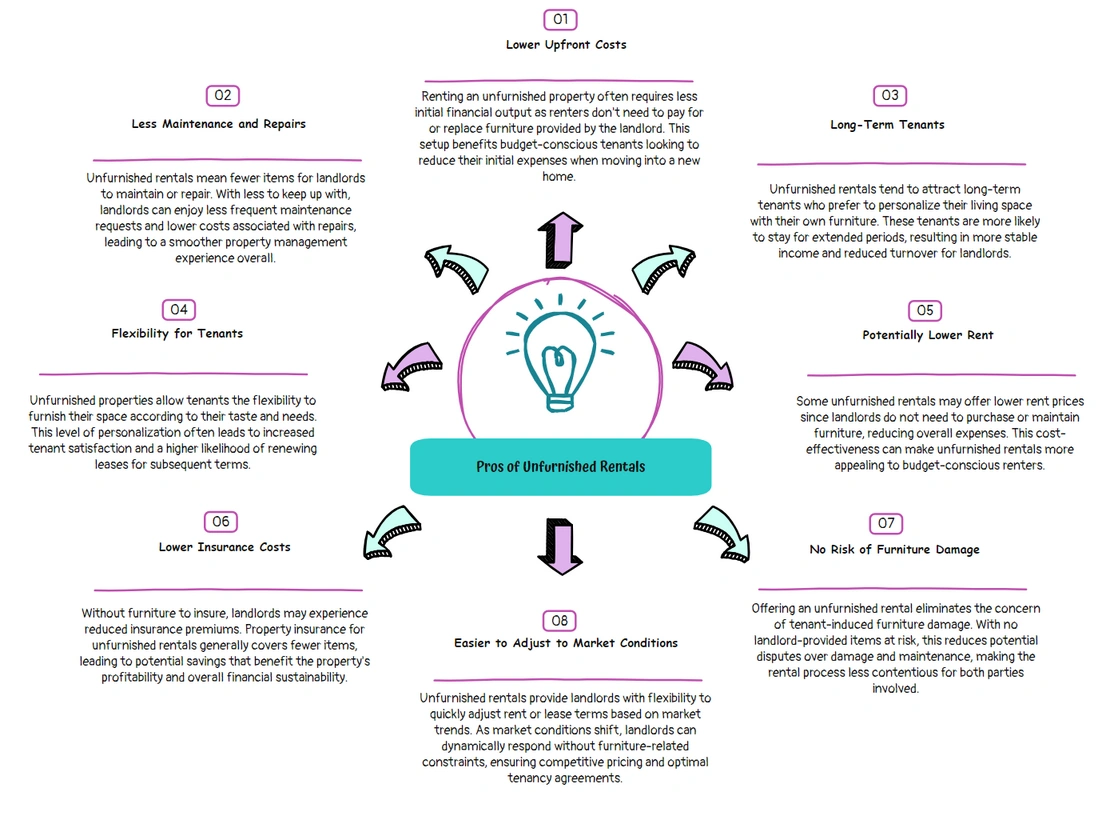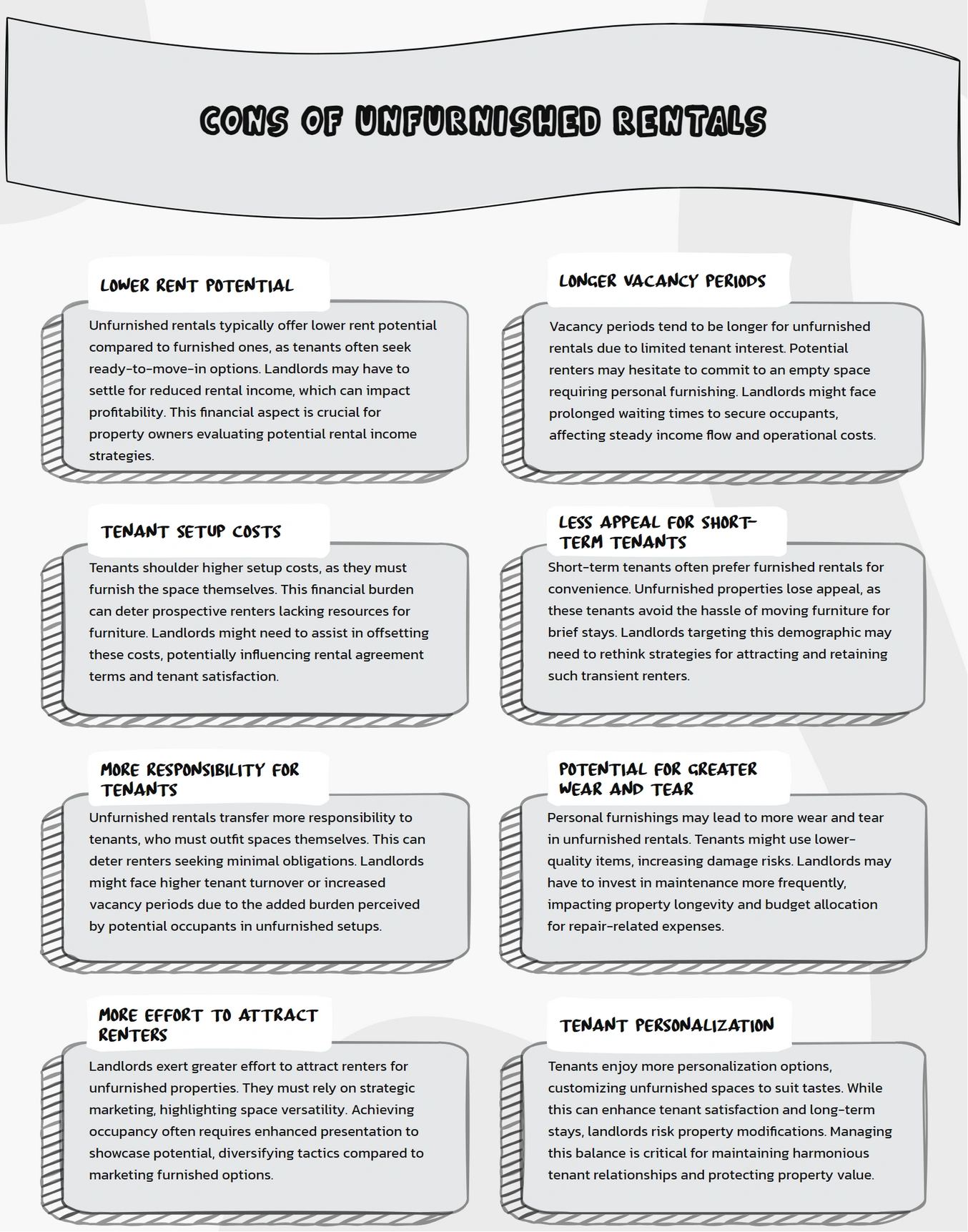Did you know furnished properties can charge 20% to 40% more rent than unfurnished ones? This big difference shows how important it is to know the pros and cons of each type. As a landlord, choosing between furnished and unfurnished rentals can really change your strategy and profits.
Things like rent prices, who you’ll rent to, and keeping the property in good shape matter a lot. In this article, we’ll explore the key points about furnished vs unfurnished rentals. We’ll give you tips to help you make the most of your investment and avoid risks.
Key Takeaways
- Furnished properties often yield higher rent, attracting a diverse tenant demographic.
- Unfurnished rentals may experience longer vacancy periods due to a limited tenant pool.
- The upfront investment for furnished properties is higher, but may lead to greater profitability.
- Furnished rentals can enhance occupancy rates, particularly in short-term rental markets.
- Tenant turnover is generally higher in furnished units, impacting your long-term planning.
What Is a Furnished Rental
A furnished rental is a property that comes with essential furniture and appliances. This means you can move in without buying your own. The furnished rental definition includes things like a bed, sofa, and kitchen appliances. These features are great for those who want convenience, like students or professionals moving for work.
Because of their convenience, furnished rentals often cost more. This is because they are ready to use right away. The rental market demands this, making them more expensive.
In Washington, D.C., renting a furnished one-bedroom apartment costs a lot more than an unfurnished one. Furnished rentals are popular with short-term tenants. They like not having to spend money and time on furniture.
Many also like part furnished rentals. These offer key furniture items but let you add your own touches. This makes your space feel more like home.
| Rental Type | Average Monthly Cost | Estimated Initial Costs | Tenant Turnover |
| Furnished Rental | $3,498 | N/A | Higher |
| Unfurnished Rental | $2,175 | $7,400.45 – $8,831.40 | Lower |
Furnished rentals are more expensive but make moving easier. They save time and meet immediate needs. Knowing about the features of furnished rentals helps landlords and tenants make better choices in the rental market.
Pros of Renting a Furnished Rental
Renting a furnished property has many benefits for landlords. It’s not just about making life easier for tenants. Furnished rentals can also mean higher earnings, attracting certain types of renters, and keeping your property in top shape.
Higher Rent Potential
Furnished rentals can bring in more money. They can charge 25% to 50% more than unfurnished ones. For instance, a $2,000 monthly rent could jump to $6,000 to $12,000 extra each year. This makes them a great choice for boosting your income.
Attracts Short-Term Renters
Furnished rentals are perfect for short-term renters. They appeal to professionals and students who need temporary homes. The ease of moving into a ready-to-go space makes them more attractive, leading to faster rentals.
More Control Over Property Condition
Providing furnishings lets you keep a closer eye on your property. You can track wear and tear better. This ensures your property and its furniture stay in great shape for the next tenants.
Appeals to Tenants with Limited Furniture
Furnished rentals are great for those without much furniture. Young professionals, students, or people moving for work often lack a full set. Offering a ready-to-move-in space attracts more tenants, improving your property’s appeal and rental rate.
Easier to Manage Short-Term Rentals
Furnished properties appeal to young professionals and corporate travelers. They want convenience, making your job easier. Renting out a furnished unit quickly means more tenants and more money with less work.
Less Vacancy Time
Furnished rentals attract more temporary tenants. This means your property is less empty. It leads to a steady income, keeping your investment profitable.
Increased Property Value
Offering a furnished rental can boost your property’s value. It lets you meet seasonal demands and stay competitive. Quality furnishings make your property more appealing and can raise your rental prices.

Cons of Renting a Furnished Rental
Furnished rentals have their perks, but landlords face some downsides. Knowing these challenges helps you manage your investment wisely.
Higher Upfront Costs
Getting a furnished rental means big upfront costs. You might spend $5,000 to $15,000 on furniture and appliances. This can hurt your cash flow, especially if you’re switching from an unfurnished place. It’s a big financial hurdle that needs careful planning.
Increased Maintenance Costs
Furnished rentals often mean more maintenance costs. Tenants might not handle the furniture as well as their own stuff. This can lead to more repairs and disputes over security deposits. Regular checks keep your property in shape.
Tenant Turnover
Furnished rentals see more tenant turnover. This can be 50% higher than unfurnished ones. You’ll spend more on marketing, cleaning, and getting the place ready for new tenants. This can cut into your income when the place is empty.
Potential for Damage
There’s a risk of damage when you provide furniture. Tenants might accidentally damage your items, leading to more maintenance and replacement costs. To protect yourself, you might need to ask for higher security deposits, up to 2 times the usual amount.
Less Flexibility in Rent
Furnished rentals usually have fixed prices. This makes it hard to change rent based on the market. During tough economic times, this can lead to longer empty periods.
Limited Market Appeal
Furnished rentals draw a smaller crowd, limiting your potential renters. If your area doesn’t attract many short-term renters, finding tenants can take longer.
Higher Insurance Costs
Insurance for furnished rentals costs more because of the risk of damage to more items. Landlords need to pay for more liability coverage. Security deposits are also higher, often 1.5 to 2 times the monthly rent.
Depreciation of Furniture
Furniture in rentals loses value over time, affecting profits. As items lose value, it’s harder to keep a good return on investment. Tenants might not take as good care of the furniture as they would their own.

What Is an Unfurnished Rental
An unfurnished rental is a property that is empty. This lets tenants make it their own. It’s great for long-term stays and families who already have furniture.
These rentals have lower upkeep costs. This is good for owners with many properties. They attract a wide range of tenants, like families and older people.
Landlords get a steady income from these rentals. Tenants tend to stay longer. This makes it easier for landlords to keep their properties profitable.
Pros of Renting an Unfurnished Rental
Renting an unfurnished rental offers many benefits for landlords. It saves money upfront. You don’t have to spend on furniture and appliances, which cuts down costs.
Lower Upfront Costs
Choosing unfurnished rentals saves money. You don’t have to spend on furniture and decor. This makes starting a rental business easier and more profitable.
Less Maintenance and Repairs
Unfurnished rentals mean less work on repairs. With fewer items, maintenance costs are lower. This saves money over time and is a big plus for landlords.
Long-Term Tenants
These rentals attract tenants who want to make their space their own. This leads to happier tenants who stay longer. Happy tenants mean steady income and less hassle for landlords.
Flexibility for Tenants
Unfurnished rentals let tenants decorate as they like. This makes them happier and more likely to stay. Happy tenants are good for business, bringing in steady income.
Potentially Lower Rent
Unfurnished rentals often have lower rents than furnished ones. This makes them attractive to tenants who want to save money. They get a good deal without giving up on location or space.
Lower Insurance Costs
Without expensive furniture, insurance costs drop. This cuts down on expenses and reduces risks. It helps avoid problems with damaged or stolen items.
No Risk of Furniture Damage
Renting an unfurnished unit means no worries about furniture getting damaged. Tenants are on their own with their belongings. This leads to a simpler landlord-tenant relationship, which can build positive long-term connections.
Easier to Adjust to Market Conditions
Unfurnished rentals are great for adapting to the rental market. Landlords can change rents quickly based on market needs. This flexibility helps them respond to tenant preferences and changes in the area.

Cons of Renting an Unfurnished Rental
Renting an unfurnished rental has its downsides for landlords. One big issue is the lower rent income it can bring. Compared to furnished rentals, unfurnished ones often have lower prices, which can cut into your earnings.
Lower Rent Potential
Unfurnished rentals usually earn less than furnished ones. This can lead to financial problems. You might not be able to charge as much, which can hurt your profits.
Longer Vacancy Periods
Unfurnished rentals often sit on the market longer. People looking for a quick move usually choose furnished homes. This means your rental might stay empty longer, reducing your income and making it harder to find tenants.
Tenant Setup Costs
Tenants of unfurnished rentals often have to buy their own furniture and appliances. This can scare off potential renters. It might make them decide not to rent your place, leading to longer vacancies.
Less Appeal for Short-Term Tenants
Unfurnished rentals don’t draw in as many short-term renters. People looking for a quick stay often prefer furnished places. If your rental isn’t fully equipped, you might miss out on this profitable group of renters.
More Responsibility for Tenants
When renting an unfurnished place, tenants have to furnish and take care of it themselves. This can scare off some renters who like the ease of furnished rentals. They have to spend time and effort making their space their own, which can be a big turn-off for some.
Potential for Greater Wear and Tear
Since tenants furnish their own places, there’s a chance they might not treat the property as well. Without quality furniture already there, renters might cause more damage over time. This adds a risk for landlords, making it harder to manage unfurnished properties.
More Effort to Attract Renters
Marketing unfurnished rentals can be tough. Many renters look for places that are already furnished. Without a clear list of amenities, your property might not get as much attention. To stand out, you’ll need to use different marketing strategies to show off your unfurnished rental.
Tenant Personalization
Letting tenants personalize their unfurnished rental can have mixed results. While they might enjoy making their space their own, it can also lead to different looks for each tenant. This can make it harder when it’s time for a new tenant to move in, as they might have different ideas for the space.

How to Choose: Furnished vs Unfurnished Rental
Choosing between furnished and unfurnished rentals can greatly impact your income and how you manage your property. You should be able to understand the local rental market before making a decision. Look at what types of tenants are in demand and what they prefer.
Do young professionals and students want furnished places, or are long-term tenants looking for stability? This information helps you decide which option is best for your property.
Think about the money side too. Furnished rentals can cost 20% to 40% more than unfurnished ones. They attract short-term tenants who need flexibility. But, unfurnished rentals have lower rents and appeal to those staying longer, reducing empty periods.
Each choice has its own set of challenges. Furnished rentals need more marketing and tenant checks because they turn over more often. They also cost more for furniture and upkeep. Unfurnished rentals, while needing a big setup investment, offer simpler management and longer tenancies.
How to Protect Your Investment If You Decide on Furnished
Protecting your investment in furnished rentals needs careful planning. You must think about risks like tenant turnover and property damage. When you take these steps, you can keep your furnishings in good shape and manage your property well.
Increase the Security Deposit
Set a higher security deposit for furnished rentals. Consider making it 1.5 to 2 times the monthly rent. This gives you a financial safety net against any damage.
This method helps cover the extra wear and tear that furnished places often face.
Carefully Vet Your Tenants
Do thorough background checks and check their references. This way, you find renters who will take care of your property and its furnishings.
Conduct Property Inspections Regularly
Do these inspections halfway through a lease to spot any damage early. Studies show properties with regular checks can save up to 25% on repairs over time.
Conclusion
Choosing between furnished and unfurnished rentals depends on market demand, tenant preferences, and your investment goals. For example, furnished apartments often have higher rents, 15-20% more than unfurnished ones.
In cities like Los Angeles and New York, this difference is even more noticeable. Furnished rentals attract students and digital nomads. This is because they offer convenience and comfort right away.
However, unfurnished properties might be better for long-term renters. They usually cost less upfront. This can save money over time, especially in longer leases.
Most rental listings are unfurnished. This gives landlords a chance to find stable tenants. It also means more exposure in the market.
Choosing the right rental type depends on your financial goals and the local tenant market. Weighing the pros and cons helps you make the best choice. This way, you can increase your income and keep your property’s value high.
FAQs
What types of tenants prefer furnished rentals?
Furnished rentals typically attract short-term tenants, such as business professionals, tourists, or people on temporary relocations. They’re also appealing to tenants who are moving from out of town and don’t have their own furniture or those in need of a flexible living arrangement.
How do furnished rentals affect tenant turnover?
Furnished rentals tend to have higher tenant turnover, as many renters seek short-term accommodation. This can lead to more frequent vacancies and the associated costs of re-advertising and screening new tenants.
Do landlords charge higher rent for furnished rentals?
Yes, landlords usually charge a premium for furnished rentals due to the added convenience and furniture. The higher rent can help offset the cost of furnishing the property and the potential for higher maintenance.
Are furnished rentals covered by different insurance policies than unfurnished properties?
Yes, furnished rentals may require a different insurance policy that covers the furniture and appliances provided. Landlords should review their policy to ensure adequate coverage for the property’s contents.

